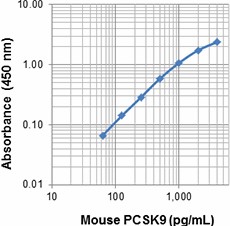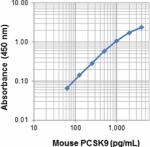- Clone
- M114G10 (See other available formats)
- Regulatory Status
- RUO
- Other Names
- Neural Apoptosis Regulated Convertase 1 (NARC1), proprotein convertase PC9, subtilisin/kexin-like protease PC9, FH3, HCHOLA3, AI415265, AI747682
- Isotype
- Rat IgG2a, κ
- Ave. Rating
- Submit a Review
- Product Citations
- publications

| Cat # | Size | Price | Quantity Check Availability | Save | ||
|---|---|---|---|---|---|---|
| 532402 | 500 µg | 465€ | ||||
Proprotein convertase subtilisin/kexin 9 (PCSK9) possesses a signal peptide, a prosegment, a catalytic domain, a hinge region, and a C-terminal Cys-His-rich domain. This protein is primarily synthesized and secreted by hepatocytes. Besides the liver, it is also expressed in the small intestine, kidney, and brain. It is also present in the plasma. Upon translocation to the endoplasmic reticulum, the prosegment of PCSK9 is autocatalytically cleaved and secreted as a stable, enzymatically inactive, non-covalent complex. Elevated low density lipoprotein-cholesterol (LDLc) level is a major risk factor for cardiovascular disease and atherosclerosis. PCSK9 is a regulator of LDLc levels through the binding of LDLR, which subsequently leads to the degradation of LDLR. PCSK9 null mice fed with a high fat diet demonstrated a four-fold decrease in cholesterol accumulation, which stresses the important role played by PCSK9 in the development of cardiovascular diseases. PCSK9 also binds to other LDLR family members such as very low density lipoprotein receptor (VLDLR), apolipoprotein E receptor (LRP1/APOER), and apolipoprotein receptor 2 (LRP8/APOER2), which leads to their degradation in intracellular acidic compartments. Like the LDLR, gene expression of PCSK9 is positively regulated by sterol regulatory element-binding protein 2 (SREBP-2), which is a transcription factor that is activated in response to cellular cholesterol depletion.
Product DetailsProduct Details
- Verified Reactivity
- Mouse
- Antibody Type
- Monoclonal
- Host Species
- Rat
- Immunogen
- In-house recombinant mouse PCSK9
- Formulation
- Phosphate-buffered solution, pH 7.2, containing 0.09% sodium azide.
- Preparation
- The antibody was purified by affinity chromatography.
- Concentration
- 0.5 mg/ml
- Storage & Handling
- The antibody solution should be stored undiluted between 2°C and 8°C.
- Application
-
ELISA Capture - Quality tested
- Recommended Usage
-
Each lot of this antibody is quality control tested by ELISA. For ELISA capture applications, a concentration of 2 µg/mL is recommended. To obtain a linear standard curve, serial dilutions of PCSK9 recombinant protein ranging from 4000 to 62.5 pg/mL is recommended for each ELISA plate. It is recommended that the reagent be titrated for optimal performance.
- Application Notes
-
ELISA Capture: The purified M114G10 antibody is useful as the capture antibody in a sandwich ELISA assay, when used in conjunction with the biotinylated Poly5251 antibody as the detecting antibody.
Note: For testing mouse PCSK9 in serum, plasma, cell culture supernatant, cell lysate, tissue homogenate, and other biological fluids, BioLegend's LEGEND MAX™ Kits (Cat. No. 443207 & 443208) are specially developed and recommended.
- RRID
-
AB_2686955 (BioLegend Cat. No. 532402)
Antigen Details
- Structure
- Monomer. The molecular mass of a full-length and mature protein is 74.8 kD and 53.7 kD, respectively.
- Distribution
-
Hepatocytes, renal cells, neuroepithelioma, and Schwann cells.
- Function
- PCSK9 regulates LDLR, VLDLR, APOER, and APOER2 levels, and therefore, LDLc levels. PCSK9 is regulated by SREBP-2.
- Interaction
- Hepatocytes.
- Ligand/Receptor
- LDLR, VLDLR, APOB, LRP1, and LRP8.
- Biology Area
- Cell Biology, Neuroinflammation, Neuroscience, Signal Transduction
- Molecular Family
- Enzymes and Regulators
- Antigen References
-
1. Seidah NG, et al. 2003. Proc. Natl. Acad. Sci. USA 100:928.
2. Naureckiene S, et al. 2003. Arch. Biochem. Biophys. 420:55.
3. Costet P, et al. 2008. Trends Biochem. Sci. 33:426.
4. Grefhorst A, et. al. 2008. J. Lipid Res. 49:1303.
5. Tavori H, et al. 2013. Circulation 127:2403.
6. Denis M, et al. 2012. Circulation 125:894.
7. Tibolla G, et al. 2011. Nutr. Metab. Cardiovasc. Dis. 21:835. - Gene ID
- 100102 View all products for this Gene ID
- UniProt
- View information about PCSK9 on UniProt.org
Related Pages & Pathways
Pages
Other Formats
View All PCSK9 Reagents Request Custom Conjugation| Description | Clone | Applications |
|---|---|---|
| Purified anti-mouse PCSK9 | M114G10 | ELISA Capture |
Compare Data Across All Formats
This data display is provided for general comparisons between formats.
Your actual data may vary due to variations in samples, target cells, instruments and their settings, staining conditions, and other factors.
If you need assistance with selecting the best format contact our expert technical support team.
 Login / Register
Login / Register 











Follow Us